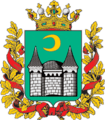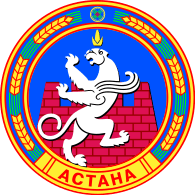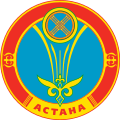Coat of arms of Nur-Sultan
The coat of arms of Nur-Sultan (formerly Astana) was adopted on 3 May 2019, shortly after the city changed its name following the resignation of longtime Kazakh President Nursultan Nazarbayev. It is identical to the previous emblem, which was personally designed by Nazarbayev, save for the name of the city. As part of the language romanization campaign undertaken by the Kazakh government, the new emblem now features the city's name in latin script, rather than the cyrillic script used in the previous iteration.[1][2]
 | |
| Use | |
|---|---|
| Adopted | 3 May 2019 |
History
The current emblem is based on the one adopted in 1998 along with the city flag, at the 16th session of the Maslihat of Astana in 1998.[3] In 2019 the city was renamed from Astana to Nur-Sultan. As the city name features on both the emblem and city flag, both insignia were updated to the new name in 2019.
Under the Russian Empire, the coat of arms featured a stylized castle on a turqoise shield. That design had several variations, with one featured leaves, while the other featured ears of cereal. The crown also varied with one version using a monarchical crown, while the other used a mural crown.
During Soviet era, the city was known as Tselinograd. It was primarily represented by a "full hands" design, which symbolized agriculture.
After the dissolution of the Soviet Union, the city was renamed from Teslinograd to Akmola and later to Astana. For the first few years after becoming the capital of an independent Kazakhsta, the city did not have an official coat of arms. Instead, it used an unofficial design featuring a medieval wall and ancient warlord superimposed on a blue shield.
The emblem the city used between 1998-2008 showed a mythical creature standing in front of a medieval fortification, flanked by ears of wheat.[4][5]
Gallery
 Coat of Arms of Akmolinsk
Coat of Arms of Akmolinsk Coat of Arms of Tselinograd
Coat of Arms of Tselinograd Coat of Arms of Astana, used 1998-2008
Coat of Arms of Astana, used 1998-2008 Coat of Arms of Astana 2008-2019
Coat of Arms of Astana 2008-2019
Notes
- February 2018, Elya Altynsarina in Nation on 26 (2018-02-26). "Kazakhstan adopts new version of Latin-based Kazakh alphabet". The Astana Times. Retrieved 2019-06-14.
- "Kazakhstan is changing its alphabet – here's why". The Independent. 2019-06-14. Retrieved 2019-06-14.
- У Астаны - новые герб и флаг. Символы города приняли вчера на 16-й сессии столичного маслихата [Astana has new flag and new coat of arms. Symbols were adopted at the 16th session of the Maslihat of Capital] (in Russian). Zakon.kz. 6 June 2008. Retrieved 22 January 2015.
- "Геральдикум - Гербы казахстана". www.heraldicum.ru. Retrieved 2019-06-14.
- "Герб города Нур-Султан | Геральдика.ру". geraldika.ru. Retrieved 2019-06-14.